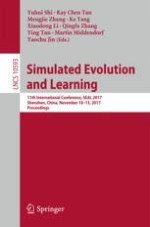2017 | OriginalPaper | Chapter
Learning to Describe Collective Search Behavior of Evolutionary Algorithms in Solution Space
Authors : Lei Liu, Chengshan Pang, Weiming Liu, Bin Li
Published in: Simulated Evolution and Learning
Publisher: Springer International Publishing
Activate our intelligent search to find suitable subject content or patents.
Select sections of text to find matching patents with Artificial Intelligence. powered by
Select sections of text to find additional relevant content using AI-assisted search. powered by
